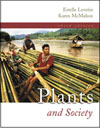
Stimulating Beverages |  |
Chapter Summary1. Caffeine and caffeinelike alkaloids have a stimulating effect on the central nervous system. Plants naturally rich in caffeine have a long history of use for alleviating fatigue and drowsiness. Historically, many of these plants have played an important role in human affairs.
2. Coffee is obtained from the seeds of Coffea arabica, a tree native to Ethiopia. Coffee drinking spread to Europe from the Middle East early in the seventeenth century, and by 1700 coffeehouses could be found throughout Europe. Coffee plantations were established in South America before 1720. The trees flourished in the hospitable climate and soil, and today Brazil and Colombia are the world’s leading coffee producers. Depulping, fermentation, and roasting are required to produce the characteristic flavor of coffee, with the roasting process the most critical and most variable. Instant coffee and decaffeinated coffee are two twentieth-century innovations to the long history of coffee.
3. Tea, made from dried tip leaves of Camellia sinensis, is the world’s most popular beverage. The tea plant is a shrub native to the area around Tibet, India, China, and Myanmar (Burma). It flourishes in tropical or subtropical areas where there is abundant rainfall. The essential oils and tannins in tea are responsible for its distinctive flavors and aromas, but the stimulating effects are due to the caffeine and theophylline present. Tea was introduced to western Europe in the seventeenth century. Its popularity was most evident in England, where it became the national beverage. By the mid-1700s the British colonists in North America were also avid tea drinkers. The Tea Act imposed by Parliament laid the foundation for the Boston Tea Party and other events leading to the Revolutionary War.
4. The seeds of Theobroma cacao are the source of both a beverage and a confection, cocoa and chocolate. The cacao tree is native to tropical Central and South America and was used to prepare a spicy beverage consumed by Aztec noblemen and priests. In the sixteenth century, Spanish conquistadors introduced the beverage to the Spanish court, where it was modified by the addition of sugar. In Europe, cocoa never rivaled coffee or tea, but the popularity increased after the first chocolate bar was developed in the mid-nineteenth century.
5. The kola tree, native to West Africa, is the source of a caffeine beverage that has been consumed increasingly since the twentieth century. Although the widespread popularity of cola drinks is apparent in contemporary society, mate, guarana, and other caffeine beverages are consumed by local populations throughout the world.
|
|
|